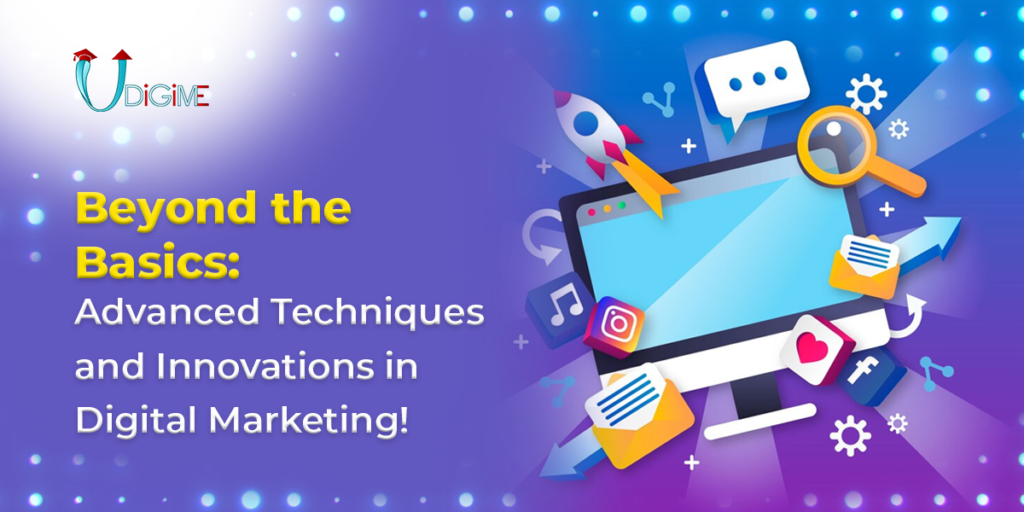The digital marketing landscape is a battlefield, and the stakes are constantly rising. Consumers are bombarded with messages, competition is fierce, and traditional tactics are quickly becoming obsolete. To stand out and conquer your target audience, you need to equip yourself with the latest weapons in the digital marketing arsenal: advanced techniques and innovations. But where do you begin? This blog delves into the exciting world of advanced digital marketing, exploring cutting-edge tactics and emerging trends that are redefining the way brands connect with their audiences. We’ll also explore how enrolling in a comprehensive digital marketing course can equip you with the knowledge and skills to master these advanced techniques and achieve remarkable results.
1. Hyper-Personalization
Gone are the days of generic marketing messages. Consumers today crave personalized experiences that cater to their specific needs and preferences. Hyper-personalization leverages data analytics and machine learning to deliver highly targeted content, offers, and recommendations across all touchpoints.
Key Techniques for Hyper-Personalization:
- Dynamic Content: Tailor website content, product recommendations, and email marketing messages based on user behavior and demographics.
- Recommendation Engines: Utilize AI-powered algorithms to suggest relevant products or services to individual users.
- Chatbots: Implement intelligent chatbots that can answer customer queries in a personalized manner and even provide product recommendations based on the conversation.
2. Artificial Intelligence (AI) and Machine Learning (ML)
AI and ML are no longer futuristic concepts – they’re revolutionizing digital marketing. These powerful technologies are transforming everything from content creation and ad targeting to customer service and campaign optimization. AI can analyze vast amounts of data to identify patterns, predict customer behavior, and automate repetitive tasks.
Utilization of AI and ML:
- Smart Bidding for Paid Advertising Platforms: AI algorithms can optimize bids in real-time to ensure maximum reach and conversions within budget constraints.
- Content Creation: AI-powered tools can generate personalized content, product descriptions, and even social media posts tailored to specific audience segments. If you’re looking to delve deeper into content marketing strategies, consider enrolling in a comprehensive digital marketing course. These courses can equip you with the skills to create high-quality, engaging content that resonates with your target audience.
- Predictive Analytics: Machine learning can predict customer behavior and preferences, allowing marketers to deliver targeted content and offers at the most opportune moments.
3. The Rise of Conversational Marketing
The digital marketing landscape is shifting towards a more two-way communication model. Conversational marketing prioritizes real-time interactions with customers through chatbots, messaging apps, and social media platforms. This approach allows brands to connect with customers on their preferred channels and provide immediate assistance. It fosters a sense of community and builds stronger brand loyalty.
Platforms for Conversational Marketing:
- Chatbots: These AI-powered virtual assistants can answer customer queries, provide product recommendations, and even troubleshoot issues 24/7.
- Messaging Apps: Platforms like WhatsApp and Facebook Messenger enable brands to have direct conversations with customers, offering support and promoting products in a personalized way. Consider incorporating a digital marketing course into your skillset to learn the best practices for utilizing these platforms effectively.
- Live Chat Features: Websites can integrate live chat features to connect with website visitors in real-time, answer questions, and potentially convert them into paying customers.
4. Embracing the Power of Influencer Marketing
Influencer marketing has become a mainstay in the digital marketing toolbox. Today, brands are increasingly collaborating with micro-influencers – individuals with smaller but highly engaged followings – to reach niche audiences and build trust. Micro-influencers often have a strong connection with their followers and can promote products or services in a more authentic and relatable way. Partnering with the right micro-influencers can be a highly effective strategy for reaching a targeted audience and driving conversions.
The Influencer Marketing Spectrum:
- Macro-Influencers: Social media celebrities with millions of followers. Effective for brand awareness campaigns but can be expensive.
- Mid-Tier Influencers: Influencers with hundreds of thousands of followers. Offer a good balance between reach and engagement.
- Micro-Influencers: Individuals with smaller, highly engaged followings (typically 10,000 to 100,000). Ideal for reaching niche audiences and building trust.
5. Augmented Reality and Virtual Reality
Today AR and VR are no longer limited to gaming. They’re making significant inroads into the digital marketing arena, offering brands innovative ways to engage with customers and showcase their products.
Immersive Marketing Applications:
- AR Product Visualization: Imagine a furniture store where customers can use an AR app to see how a sofa would look in their living room before purchasing it.
- VR Travel Experiences: Travel companies can offer immersive VR tours of destinations, allowing potential tourists to explore virtually before booking their trip.
- AR Product Try-On: Cosmetic brands can develop AR apps that allow customers to virtually try on makeup shades before buying them.
6. Voice Search Optimization
With the rise of voice assistants like Siri and Alexa, voice search is becoming an increasingly popular way for people to search for information and products online. Marketers need to optimize their websites and content for voice search by using long-tail keywords and natural language queries.
Optimizing for Voice Search:
- Long-Tail Keywords: Focus on long-tail keywords that people might use when speaking a natural language search query.
- Conversational Language: Craft website content that reads like natural conversation, incorporating questions and phrases people might use in a voice search.
- Fast-Loading Websites: Voice search users expect instant results. Ensure your website has a fast loading speed for optimal user experience.
Conclusion
The digital marketing landscape is constantly evolving, and those who remain stagnant will be left behind. By embracing advanced techniques and innovations like hyper-personalization, AI & ML, conversational marketing, and immersive technologies, businesses can unlock new opportunities for customer engagement and achieve remarkable results. The key is to stay informed about the latest trends, experiment with new strategies, and continuously adapt your approach to stay ahead of the curve. The future of digital marketing is bright, and those who embrace change will be the ones who thrive.


